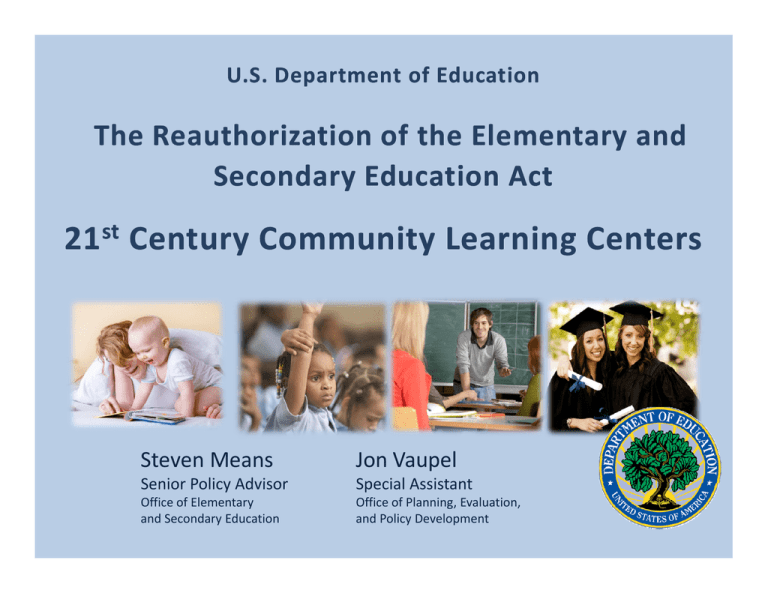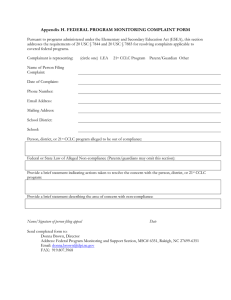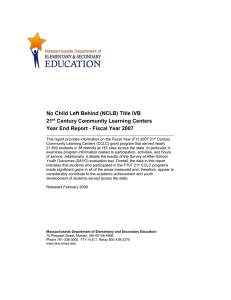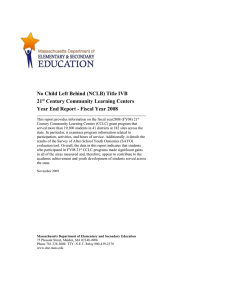The Reauthorization of the Elementary and Secondary Education Act
advertisement

U.S. Department of Education The Reauthorization of the Elementary and Secondary Education Act Secondary Education Act 21st Century Community Learning Centers Steven Means Jon Vaupel Senior Policy Advisor Senior Policy Advisor Special Assistant Special Assistant Office of Elementary and Secondary Education Office of Planning, Evaluation, and Policy Development “We We must support families, communities and must support families, communities and schools working in partnership to deliver services services and supports that address the full and supports that address the full range of student needs.” ‐ President Obama Overarching Goal “By 2020, America will once again have the highest proportion of college the highest proportion of college graduates in the world.” President Barack Obama, February 24, 2009 , y , A Comprehensive, Cradle‐to‐Career Strategy Early Learning (Birth‐grade 3) Goal: All kindergarten students arrive ready to learn and remain on track to 4th grade. Elementary (Grades K‐5) Secondary (Grades 6‐12) Goal: All students enter middle school with foundational skills to tackle advanced subjects. Goal: All students graduate high school ready for college and career. Post‐ Secondary Goal: All graduates have opportunities for success in the 21st century economy. Priorities for Reform More time for Learning: In Race to the Top: the program provides an invitational priority to create the the program provides an invitational priority to create the conditions for reform, innovation, and learning – including programs that increase learning time. School Improvement Grants: school turnaround models include efforts to increase learning time. Nonprofits and CBOs will play crucial roles in identifying and implementing innovative and effective ways to increase learning time innovative and effective ways to increase learning time. Policy y Objectives j of the Blueprint Equity and Equity and Excellence Teaching and Learning Building Building Capacity Building the Capacity of the System Implement systemic reforms and pioneer new models “Race to the Top” Competitive grants for states and districts for systemic reforms that will accelerate implementation of effective practice. “Investing in Innovation” Develop and scale up promising instructional practices, strategies, and supports. Support schools in doing more to meet student needs Safe & Healthy Students Ensure students are safe, healthy, well‐supported. Community-Wide Approach Develop comprehensive, community‐based systems of supports and services. More Time for Learning Support afterschool and a longer, re‐structured school day. Technology Support students & teachers with tools & resources for learning Strengthen foundational supports for historically underserved children Low-income students Significant funding for low‐income students. Students with Disabilities Support through ESEA & IDEA. English Learners Funding to ensure access to strong programs. Homeless, Migrant, Indians Rural, Indians, Rural Impact Aid, Aid Neglected & Delinquent Across ESEA: A Focus on More Time for Learning Offers more time and supports for students and teachers to focus on teaching and learning, especially in the lowest performing schools the lowest performing schools Supports well‐rounded education. Provides safe, supportive environments. Provides comprehensive supports for students. Provides comprehensive for students Successful, Safe and Healthy St d t ‐ St t Students ‐ Students Structure Successful, Safe, & Healthy Students ($410m) Implement climate measurement systems to target resources to: • improve school safety and strengthen family & student engagement; • improve students’ i t d t’ physical & mental health. Promise P i Neighborhoods ($210m) Create birth-throughcollege-and-careercontinuum of: • effective community services; • strong family supports; • comprehensive education reform. 21st Century Community Learning C it L i Centers ($1.2b) Strengthen community learning centers & support more learning time including: • After‐, before‐, and summer school programs; • expanded learning time; • full‐service community schools. 21st Century Community Learning Centers St t Structure Competitive p Grants from ED to States and districts Districts may apply alone or in partnership with a nonprofit (including CBOs) or local governmental entity. States subgrant funds to districts, nonprofits (including CBOs) and partnerships. Grants would be for 3 years, with the possibility of up to a 2 year extension if achieving intended outcomes. 21st CCLC ‐‐ Additional Time and Supports Community Learning Centers High‐quality: • Before school • After school After school • Summer school School based or Non‐school based Expanding the School Day Comprehensively Comprehensively redesigning and expanding the school day for ALL students day for ALL students. More time for students students. More time for teacher collaboration. Full-Service Full Service Community Schools Schools are the center of the community, y providing access to comprehensive services at the school site All 21st CCLC programs will focus on: N t “More Not “M off the th Same” S ” Improving student academic achievement in core subjects; Providing enrichment activities; Aligning g g activities with the regular g p program g of the school (or schools); Offering greater opportunities for families to actively and meaningfully engage in their children’s children s education; and Encouraging regular student participation. Priorities in 21st CCLC Priorities Improving Challenge schools (lowestperforming schools) Comprehensively redesigning and expanding di g the th school h l schedule h d l for f all ll students Full-service community schools Partnerships p “All of us have a role to play in building an education f p y g system that is worthy of our children and ready to help us seize the opportunities and meet the challenges of the 21st century.” ‐ President Obama




